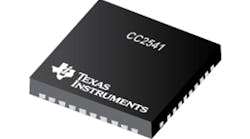Addressing the increasingly connected car, Texas Instruments’ SimpleLink Bluetooth CC2541-Q1 wireless microcontroller (MCU) offers a lower-power option to smartphone-controlled and wire-replacement applications. Combined with the company’s BLE-Stack software and development kits, it becomes a one-chip solution for automotive connectivity combining Bluetooth, Wi-Fi, and GNSS, as well as offering over-the-air download support for “in-field” updates.
Smartphone-controlled applications include keyless entry using a Bluetooth Smart Ready smartphone or key fob; LED lighting controls; diagnostic information to help understand engine warning lights; and services with iBeacon technology for fast discovery and easy pairing with in-car Bluetooth Smart technology. Wire-replacement apps help reduce weight, which in turn boosts fuel economy. They range from wireless infotainment controls in the steering wheel, to low-data-rate systems (for control, personalization settings, and alerts via smartphone), to Bluetooth Smart remotes for rear-seat entertainment.
Features of the 6- by 6-mm device includes ultra-low-power Bluetooth operation enabling operation on a coin-cell battery, less than 1 µA of sleep current with real-time clock (RTC) and RAM retention, and a 95-dB link budget. Flash-based firmware can be updated in the field, and persistent data can be stored on-chip. Support is planned for Bluetooth 4.1 and 250-kbit/s, 500-kbit/s, 1-Mbit/s, and 2-Mbit/s proprietary modes. Operating temperature ranges from ‒40 to 105°C.
The CC2541-Q1 is directed at an emerging market of new automotive features for Bluetooth Smart technology. TI reports that while it’s currently sampling the product, the MCU will become available in the third quarter of 2014.
